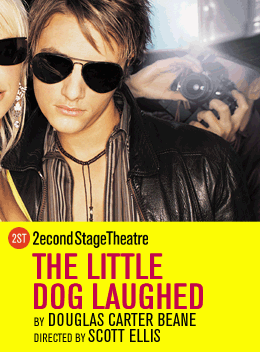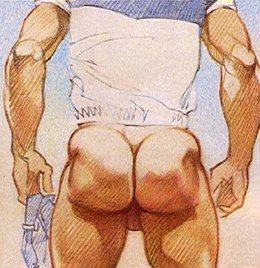New Guthrie is industrial
Commentary: New Guthrie is industrial on the outside, dazzling on the inside
In his Guthrie Theater on the Minneapolis riverfront, architect Jean Nouvel has created a powerful play of illusion and reality. The design pays homage to its industrial neighbors while capturing the magic of theater.
By Linda Mack
One building can define a generation's legacy.
For the last generation, it was the Guthrie Theater on Vineland Place. Ralph Rapson's facade of rhythmic openings framed people moving inside the theater lobby and created a surge of anticipation.
For this generation, it will once again be the Guthrie Theater, the new one opening next weekend. The powerful building establishes a cultural anchor on the formerly blighted Minneapolis riverfront. In homage to its environs, French architect Jean Nouvel's monumental blue box looks industrial on the outside. Inside, it's dazzling.
Blue and yellow windows color reality. Faint images of Guthrie actors cover lobby walls and ceilings. More actors appear in holograms recessed into walls and lurk in mirrors. Framed views recast the Mississippi riverfront. These optical effects create a cinematic experience -- before the plays have even begun.
"We're going to have to match it, play by play," said Guthrie artistic director Joe Dowling one day as he waited for Nouvel to meet him on the already famous cantilevered bridge, the epicenter of jaw-dropping experiences.
The new Guthrie, 10 stories at its tallest, is more than imposing. Seen from the Stone Arch Bridge, its scale matches that of its once-industrial neighbors. Stand close and it's huge. In an age of architectural highjinks -- roof forms that slide over each other, eccentric angles and curves, odd materials -- the exterior is surprisingly straightforward, except for that half-block cantilevered bridge jutting toward the river, of course. The powerful geometric forms wrapped in blue metal panels recall the shapes of the nearby historic mills and grain elevators.
"A building is always an echo -- it's always part of a long story," Nouvel said on a recent tour of the building.
The midnight blue color is part of another story. After a false start in yellow, Nouvel searched more than a year for just the right color to convey the mystery of theater.
"I looked at cars all day and finally found one," he said. "To find the right color is very, very important."
The theatrical activity inside is hinted at by intriguing exterior elements: the semi-circular form of the thrust stage, which softens the building on the corner facing downtown; the orange glass box perched high on the tower, which locates the third or black-box stage; the ghostly images of Guthrie productions glistening in the blue walls; the scrolling LED roof towers and the supersized faces of playwrights, including George Bernard Shaw, Tennessee Williams and August Wilson, on the restaurant terrace.
A heart-throbbing interior
The pow-bang comes inside, but not right away, when you walk into the two-story ground-floor lobby that cuts through to the equally big doors on the Mississippi side. The space is a palate-cleanser for what's to come: a long, claustrophobic escalator ride that disgorges you on the fourth-floor lobby, right in front of a huge window highlighting a riverfront view.
"You go from one world to another world," Nouvel said.
There in the dark, seemingly low-ceilinged lobby, faint images of Guthrie actors loom overhead and on the walls. The sound of people in the fifth-floor lobby floats down through two backlit semicircles cut in the ceiling.
"You feel the other people above, and the warm color," Nouvel said. "You feel the magic of the theater."
Instinct draws you to the bridge, which functions as an elaborate extension of the lobby. Like an architectural scissors, the ramp up from the fourth floor meets the ramp down from the fifth floor toward the end of the bridge. Odd-shaped windows with deep, mirrored sides reflect and literally turn riverfront views upside-down. A 10-foot high window opens to capture the sound and sight of St. Anthony Falls.
Then the blue glass doors and panels at the end of the bridge draw your attention.
"The color flattens the view, makes it abstract," Nouvel said. "You want to go through and see the next adventure."
And, when you do, the whole riverfront is laid before you. Broad steps invite you to sit and soak it up. You're suspended four stories in the air.
"This is the fourth stage," Nouvel said, as he soaked up the sun.
Captivating stages
The other three stages are equally captivating. The 1,100-seat thrust stage, the old Guthrie's signature, feels like a crisp, warmer version of the familiar Vineland Place stage. Rapson's groundbreaking layout and vibrant scheme of 10 seat colors have been kept, but details have been tweaked for better sightlines, comfort and acoustics. (Leg room, for one thing, has been increased.)
The 700-seat proscenium stage -- this theater's signature -- is lipstick red with velvet seats, sensuous chain-mail curtains cascading down the walls and two narrow balconies perched above the raked floor. If color can whet the theatrical appetite, patrons will be ravenous.
The flexible black-box theater on the ninth floor is actually deep charcoal gray. Its cantilevered orange-glass lobby, which sports both a glass ceiling and a glass floor, is another optical game.
"It's like a projector on the landscape. It's always sunny," said Nouvel.
Visual play before the plays
Will all this visual play compete with the theatrical experience itself? Will the plays seem dull in comparison? Will patrons eating in the fifth-floor restaurant feel they're being watched by Guthrie actors in the mirrored walls? We'll only know when people begin to fill the lobbies and theaters.
But it seems that Nouvel has succeeded where so many avant-garde architects fail.
He's transformed the way we see the city's iconic natural asset -- the Mississippi River. And he welcomes us to share the fun he had doing so.
He's masterfully manipulated our experience of the building. But he's done so by inviting us through it rather than forcing us.
Like the old Guthrie, the new one beckons us to the theater. That invitation, even more than the resurrected thrust stage, continues a compelling cultural legacy.
Linda Mack • 612-673-7124 lmack@startribune.com
©2006 Star Tribune.
In his Guthrie Theater on the Minneapolis riverfront, architect Jean Nouvel has created a powerful play of illusion and reality. The design pays homage to its industrial neighbors while capturing the magic of theater.
By Linda Mack
One building can define a generation's legacy.
For the last generation, it was the Guthrie Theater on Vineland Place. Ralph Rapson's facade of rhythmic openings framed people moving inside the theater lobby and created a surge of anticipation.
For this generation, it will once again be the Guthrie Theater, the new one opening next weekend. The powerful building establishes a cultural anchor on the formerly blighted Minneapolis riverfront. In homage to its environs, French architect Jean Nouvel's monumental blue box looks industrial on the outside. Inside, it's dazzling.
Blue and yellow windows color reality. Faint images of Guthrie actors cover lobby walls and ceilings. More actors appear in holograms recessed into walls and lurk in mirrors. Framed views recast the Mississippi riverfront. These optical effects create a cinematic experience -- before the plays have even begun.
"We're going to have to match it, play by play," said Guthrie artistic director Joe Dowling one day as he waited for Nouvel to meet him on the already famous cantilevered bridge, the epicenter of jaw-dropping experiences.
The new Guthrie, 10 stories at its tallest, is more than imposing. Seen from the Stone Arch Bridge, its scale matches that of its once-industrial neighbors. Stand close and it's huge. In an age of architectural highjinks -- roof forms that slide over each other, eccentric angles and curves, odd materials -- the exterior is surprisingly straightforward, except for that half-block cantilevered bridge jutting toward the river, of course. The powerful geometric forms wrapped in blue metal panels recall the shapes of the nearby historic mills and grain elevators.
"A building is always an echo -- it's always part of a long story," Nouvel said on a recent tour of the building.
The midnight blue color is part of another story. After a false start in yellow, Nouvel searched more than a year for just the right color to convey the mystery of theater.
"I looked at cars all day and finally found one," he said. "To find the right color is very, very important."
The theatrical activity inside is hinted at by intriguing exterior elements: the semi-circular form of the thrust stage, which softens the building on the corner facing downtown; the orange glass box perched high on the tower, which locates the third or black-box stage; the ghostly images of Guthrie productions glistening in the blue walls; the scrolling LED roof towers and the supersized faces of playwrights, including George Bernard Shaw, Tennessee Williams and August Wilson, on the restaurant terrace.
A heart-throbbing interior
The pow-bang comes inside, but not right away, when you walk into the two-story ground-floor lobby that cuts through to the equally big doors on the Mississippi side. The space is a palate-cleanser for what's to come: a long, claustrophobic escalator ride that disgorges you on the fourth-floor lobby, right in front of a huge window highlighting a riverfront view.
"You go from one world to another world," Nouvel said.
There in the dark, seemingly low-ceilinged lobby, faint images of Guthrie actors loom overhead and on the walls. The sound of people in the fifth-floor lobby floats down through two backlit semicircles cut in the ceiling.
"You feel the other people above, and the warm color," Nouvel said. "You feel the magic of the theater."
Instinct draws you to the bridge, which functions as an elaborate extension of the lobby. Like an architectural scissors, the ramp up from the fourth floor meets the ramp down from the fifth floor toward the end of the bridge. Odd-shaped windows with deep, mirrored sides reflect and literally turn riverfront views upside-down. A 10-foot high window opens to capture the sound and sight of St. Anthony Falls.
Then the blue glass doors and panels at the end of the bridge draw your attention.
"The color flattens the view, makes it abstract," Nouvel said. "You want to go through and see the next adventure."
And, when you do, the whole riverfront is laid before you. Broad steps invite you to sit and soak it up. You're suspended four stories in the air.
"This is the fourth stage," Nouvel said, as he soaked up the sun.
Captivating stages
The other three stages are equally captivating. The 1,100-seat thrust stage, the old Guthrie's signature, feels like a crisp, warmer version of the familiar Vineland Place stage. Rapson's groundbreaking layout and vibrant scheme of 10 seat colors have been kept, but details have been tweaked for better sightlines, comfort and acoustics. (Leg room, for one thing, has been increased.)
The 700-seat proscenium stage -- this theater's signature -- is lipstick red with velvet seats, sensuous chain-mail curtains cascading down the walls and two narrow balconies perched above the raked floor. If color can whet the theatrical appetite, patrons will be ravenous.
The flexible black-box theater on the ninth floor is actually deep charcoal gray. Its cantilevered orange-glass lobby, which sports both a glass ceiling and a glass floor, is another optical game.
"It's like a projector on the landscape. It's always sunny," said Nouvel.
Visual play before the plays
Will all this visual play compete with the theatrical experience itself? Will the plays seem dull in comparison? Will patrons eating in the fifth-floor restaurant feel they're being watched by Guthrie actors in the mirrored walls? We'll only know when people begin to fill the lobbies and theaters.
But it seems that Nouvel has succeeded where so many avant-garde architects fail.
He's transformed the way we see the city's iconic natural asset -- the Mississippi River. And he welcomes us to share the fun he had doing so.
He's masterfully manipulated our experience of the building. But he's done so by inviting us through it rather than forcing us.
Like the old Guthrie, the new one beckons us to the theater. That invitation, even more than the resurrected thrust stage, continues a compelling cultural legacy.
Linda Mack • 612-673-7124 lmack@startribune.com
©2006 Star Tribune.










0 Comments:
Post a Comment
<< Home